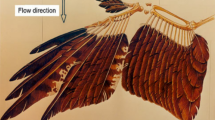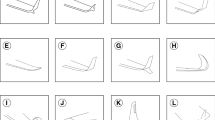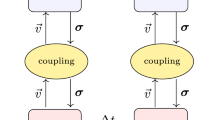Abstract
Humpback whales have higher hydrodynamic maneuverability due to the unique protuberance structures on the leading edge of their flippers. The leading-edge protuberance, therefore, is regarded as an attractive flow control method. Although some results have shown the effect of the leading-edge protuberance on a static airfoil, its effect on the aerodynamic characteristics of dynamic airfoils is still not clear. In present study, direct force measurements are conducted on dynamic NACA 0012 wings with sinusoidal leading-edge protuberances as well as a baseline configuration at a low Reynolds number of 2 × 104. Three typical motions of the wing, including pitching, plunging, and combined pitching-plunging, are employed to examine the effect of motion styles on aerodynamic characteristics of airfoils. Under the static case, it is found that leading-edge protuberances delay the stall angle of attack of airfoils by about 67%, and increase the maximum lift coefficient, which are different from previous studies of thick straight wings, such as NACA 634–021, NACA 0020, and NACA 0021. Under dynamic cases, motion styles have a significant effect on the aerodynamic characteristics of airfoils. The lift coefficient of the modified airfoil becomes larger than the baseline airfoil mainly at upstroke phases for pitching motion, downstroke phases for plunging motion, and all phases for combined pitching-plunging motion, considering positive angles of attack. Compared to the static condition, the range of angles of attack where the lift of the modified airfoil is larger than the baseline airfoil extends; however, the lift difference between both airfoils decreases. Under pitching motion, phase-locked two-dimensional particle image velocimetry is performed to investigate the mechanism behind different aerodynamic characteristics between two dynamic airfoils. It is revealed that leading-edge protuberances inhibit formation of the secondary vortex, and weaken coherency of the leading-edge vortex (LEV). The flow acceleration effect of trough planes, different evolution of the LEV and the spanwise flow on the upper surface, are the main reasons that affect the aerodynamic characteristics of the modified airfoil.
Graphic abstract















Similar content being viewed by others
References
Baik YS, Bernal LP, Granlund K, Ol MV (2012) Unsteady force generation and vortex dynamics of pitching and plunging aerofoils. J Fluid Mech 709:37–68
Benaissa M, Ibrahim IH, New TH, Ho WH (2017) Effect of leading edge protuberance on thrust production of a dynamically pitching airfoil. Top Probl Fluid Mech, Prague 2017:23–30
Benyus JM (1997) Biomimicry: innovation inspired by nature. HarperCollins, New York
Borg J (2012) The effect of leading edge serrations on dynamic stall. Doctor’s thesis, University of Southampton
Carr LW (1988) Progress in analysis and prediction of dynamic stall. J Aircr 25(1):6–17
Champagnat F, Plyer A, Le Besnerais G, Leclaire B, Davoust S, Le Sant Y (2011) Fast and accurate PIV computation using highly parallel iterative correlation maximization. Exp Fluids 50(4):1169–1182
Cleaver D, Wang Z, Gursul I (2010) Vortex mode bifurcation and lift force of a plunging airfoil at low Reynolds numbers. AIAA Paper 2010–390
Custodio D, Henoch CW, Johari H (2015) Aerodynamic characteristics of finite span wings with leading-edge protuberances. AIAA J 53(7):1878–1893
Fish FE, Battle JM (1995) Hydrodynamic design of the humpback whale flipper. J Morphol 225(1):51–60
Hansen KL, Kelso RM, Dally BB (2012) Performance variations of leading-edge tubercles for distinct airfoil profiles. AIAA J 49(1):185–194
Hansen KL, Rostamzadeh N, Kelso RM, Dally BB (2016) Evolution of the streamwise vortices generated between leading edge tubercles. J Fluid Mech 788:730–766
Hou YF, Li ZP (2020) Effect of bionic sinusoidal leading-edge on dynamic stall of airfoil. Acta Aeronautica et Astronautica Sinica 41(1):123276 (in Chinese)
Hrynuk JT, Bohl DG (2020) The effects of leading-edge tubercles on dynamic stall. J Fluid Mech 893:A5
Johari H, Henoch C, Custodio D, Levshin A (2007) Effects of leading-edge protuberances on airfoil performance. AIAA J 45(11):2634–2642
Lee T, Gerontakos P (2004) Investigation of flow over an oscillating airfoil. J Fluid Mech 512:313–341
Li ZY, Feng LH, Kissing J, Tropea C, Wang JJ (2020) Experimental investigation on the leading-edge vortex formation and detachment mechanism of a pitching and plunging plate. J Fluid Mech 901:A17
McCroskey WJ (1982) Unsteady airfoils. Annu Rev Fluid Mech 14:285–311
Miklosovic DS, Murray MM, Howle LE, Fish FE (2004) Leading-edge tubercles delay stall on humpback whale (Megaptera novaeangliae) flippers. Phys Fluids 16(5):L39–L42
Mulleners K, Raffel M (2013) Dynamic stall development. Exp Fluids 54(2):1469
New DTH, Ng BF (2020) Flow control through bio-inspired leading-edge tubercles. Springer, Cham
Pan C, Xue D, Xu Y, Wang JJ, Wei RJ (2015) Evaluating the accuracy performance of Lucas-Kanade algorithm in the circumstance of PIV application. Sci China Phys Mech Astron 58(10):1–16
Raffel M, Willert CE, Wereley ST, Kompenhans J (2007) Particle image velocimetry. Springer, Berlin
Rostamzadeh N, Hansen KL, Kelso RM, Dally BB (2014) The formation mechanism and impact of streamwise vortices on NACA 0021 airfoil’s performance with undulating leading-edge modification. Phys Fluids 26(10):107101
Schlüter J (2009) Lift enhancement at low Reynolds numbers using pop-up feathers. AIAA Paper 2009–4195
Skillen A, Revell A, Pinelli A, Piomelli U, Favier J (2014) Flow over a wing with leading-edge undulations. AIAA J 53(2):464–472
Stanway MJ (2008) Hydrodynamic effects of leading-edge tubercles on control surfaces and in flapping foil propulsion. Doctor’s thesis, Massachusetts Institute of Technology
Wang JJ, Feng LH (2019) Flow control techniques and applications. Cambridge University Press, Cambridge
Wang Y, Hu W, Zhang S (2014) Performance of the bio-inspired leading edge protuberances on a static wing and a pitching wing. J Hydrodyn 26(6):912–920
Weber PW, Howle LE, Murray MM, Miklosovic DS (2011) Computational evaluation of the performance of lifting surfaces with leading-edge protuberances. J Aircr 48(2):591–600
Wei Z, New TH, Cui YD (2015) An experimental study on flow separation control of hydrofoils with leading-edge tubercles at low Reynolds number. Ocean Eng 108:336–349
Yasuda T, Fukui K, Matsuo K, Minagawa H, Kurimoto R (2019) Effect of the Reynolds number on the performance of a NACA0012 wing with leading edge protuberance at low Reynolds numbers. Flow Turbul Combust 102:435–455
Zhang SD, Hu WR (2015) The numerical study of bionic wavy leading-edge wing in dynamic stall control. J Hydrodyn: A 30(1):24–32 (in Chinese)
Zhang MM, Wang GF, Xu JZ (2013) Aerodynamic control of low-Reynolds-number airfoil with leading-edge protuberances. AIAA J 51(8):1960–1971
Zhao M, Zhang MM, Xu JZ (2017) Numerical simulation of flow characteristics behind the aerodynamic performances on an airfoil with leading edge protuberances. Eng Appl Comput Fluid Mech 11(1):193–209
Zhou J, Adrian RJ, Balachandar S, Kendall TM (1999) Mechanisms for generating coherent packets of hairpin vortices in channel flow. J Fluid Mech 387:353–396
Acknowledgements
This work was supported by the National Natural Science Foundation of China (Nos. 11972063, 11721202).
Author information
Authors and Affiliations
Corresponding author
Additional information
Publisher's Note
Springer Nature remains neutral with regard to jurisdictional claims in published maps and institutional affiliations.
Rights and permissions
About this article
Cite this article
Wang, T., Feng, LH. & Li, ZY. Effect of leading-edge protuberances on unsteady airfoil performance at low Reynolds number. Exp Fluids 62, 217 (2021). https://doi.org/10.1007/s00348-021-03310-8
Received:
Revised:
Accepted:
Published:
DOI: https://doi.org/10.1007/s00348-021-03310-8




